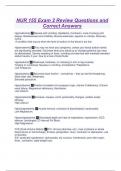NUR 155 Exam 2 Review Questions and
Correct Answers
Hyponatremia ✅Nausea and vomiting, Headache, Confusion, Loss of energy and
fatigue, Restlessness and irritability, Muscle weakness, spasms or cramps, Seizures,
Coma.
A condition that occurs when the level of sodium in the blood is too low.
Hypernatremia ✅You may not have any symptoms, unless your blood sodium levels
are significantly elevated. Dizziness when you stand up or change positions (you may
be dehydrated). Severe sweating or fever; vomiting and diarrhea with markedly elevated
sodium levels, if your. Due to a loss of body fluids.
Hypokalemia ✅Weakness, tiredness, or cramping in arm or leg muscles,
Tingling or numbness, Nausea or vomiting, Constipation, Palpitations.
Low Potassium
Hyperkalemia ✅Abnormal heart rhythm -- arrhythmia -- that can be life-threatening,
Slow heart rate, Weakness.
Elevated potassium.
Hypocalcemia ✅Positive chvostek's & trousseau's sign, vitamin D deficiency, Chronic
renal failure, Magnesium deficiency, Alcoholism.
Low calcium.
Hypercalcemia ✅Anorexia, nausea, vomit, personality changes, cardiac arrest,
lethargy.
High calcium
Hypomagnesemia ✅muscle tremors, confusion & disorientation, tachycardia.
Low Magnesium.
Hypermagnesemia ✅Decreased depth and rate of respirations, hypotension, ECG
abnorm. (prolonged QT interval) AV Block.
High Magnesium.
FVD (Fluid Volume Deficit) ✅R/C- GI loss (diarrhea, etc.), loss of plasma or whole
blood (burns or hemorrhage), Excess. perspiration, fever, confusion or depression, use
of diuretics
S/S- posturaly hypotension, tachycardia, dry mucous, membranes, poor skin turgor,
thirst , confusion, rapid weight loss.
, Respiratory Acidosis ✅R/C- Pneumonia, cystic fibrosis, respiratory failure, airway
obstruction, chest wall injury
S/S- confusion, dizziness,lethargy, headache, vent. dysrhythmias
Respiratory Alkalosis ✅R/C- Asthma, Pneumonia, Wrong Ventilator Settings
S/S- tachypnea, dizziness,confusion, dysrhythmias, numbness & tingling of extremeties.
Metabolic Acidosis ✅R/C- Starvation, Renal Failure, Lactic Acidosis from heavy
exercise, Diabetic ketoacidosis
S/S- headache, lethargy, confusion, dysrhtymias, flushed skin, tachypnea w/ deep
respirations, abdominal cramps.
Metabolic Alkalosis ✅R/C- Excessive vomiting, Prolonged gastric suctioning,
Hypokalemia or hypercalcemia, excess aldosterone,
S/S- dizziness, dysrhytmias, tingly fingers and toes.
Isontonic Solution ✅Solution w/ the same osmolarity as blood plasma; both sides of
the semipermeable membrane are equal in concentration.
Hypertonic Solution ✅HIGH osmotic pressure, PULLS fluid from cells.
Hypotonic Solution ✅Solution of lower concentration. Moves fluid into cells causing
them to enlarge
Insensible Water Loss ✅Loss of water through the skin and lungs
Sensible Water Loss ✅excess perspirations and can be perceived by the client
through inspection
Lungs & Kidneys ✅Physiological buffers of acid bace balance
Hyperventilation ✅In relation to PaCO2 ( when PaCO2 is < 35mmHg, rate and depth
of respiration increase, more CO2 exhaled and the carbon dioxide concentration
decreases)
Hypoventilation ✅In relation to PaCO2 ( PaCO2 is >45mmHg, rate and depth of
respiration decrease, less CO2 is exhaled, increases concentration of CO2)
Objective ✅Subjective or objective?
Complete blood count normal (CBC)
Subjective ✅Subjective or objective?
Denies nausea, vomiting, diarrhea (N/V/D)




